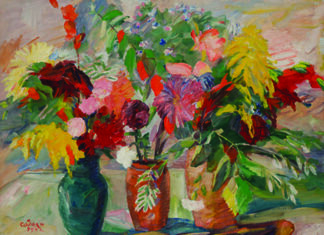BURBANK, Calif. — Born Karnik Zouloumian on January 1, 1907 in Syria to an Armenian family, Carzou later created his name from the first syllables of his first name and surname. Becoming a world traveler at an early age, Carzou was educated in Cairo, Egypt before moving to Paris in 1924 at the age of 17 to study art and architecture in earnest.
Carzou mastered a number of mediums, though his line drawings and engravings would become well known as illustrations for some of the 20th century’s most revered writers, including Hemingway, Albert Camus, Ionesco and Rimbaud. Carzou produced stunning work of painted glass and porcelain, in pencils, gauche and pastels as well as oils, often choosing to work on textured or irregular fabrics and papers rather than traditional canvas.
In July 1977, Jacques Chirac, the French prime minister, presided over Carzou’s retrospective exhibition at the Château de Val in Corrèze. There were also retrospective exhibitions in Switzerland, Luxembourg, Rochecheouart, the Château des Hayes and Pérouges, near Lyons. Carzou was awarded the National Order of Merit by the president of the republic. In December of the same year, he was made a member of the Académie des Beaux-Arts, where he replaced Jean Bouchaud. On April 4, 1979, he became a member of the Institut de France.
One of the artist’s master works, completed in his 80s, was the Apocalypse of Saint Joan in the Chapel at Manosque in Vaucluse, France, which depicted not merely the passion of the saint and national hero, but the ravages of war. Carzou, like his contemporaries Hemingway, Dali and Picasso (though in an interview the artist criticized Picasso for being “vulgar”), was part of a generation that witnessed many wars. Haunted to the point of obsession by the horrors he had witnessed, Carzou’s work went through a period where the artist seemed to be desperate to remind the world of the holocausts past, perhaps in warning. His work on the Chapel de Manosque, one of the oldest churches in France, became his own fitting tribute when it was dedicated as the Museum de Jean Carzou in 1995.
Under the auspices of Archbishop Hovnan Derderian and patronage of Diocesan benefactors Antranik and Virginia Zorayan, the Zorayan Museum will honor Carzou with an exhibition. The opening reception will be held on September 15 at 7 p.m. at the Zorayan Museum of the Western Diocese. For more information, visit www.armenianchurchwd.com.








